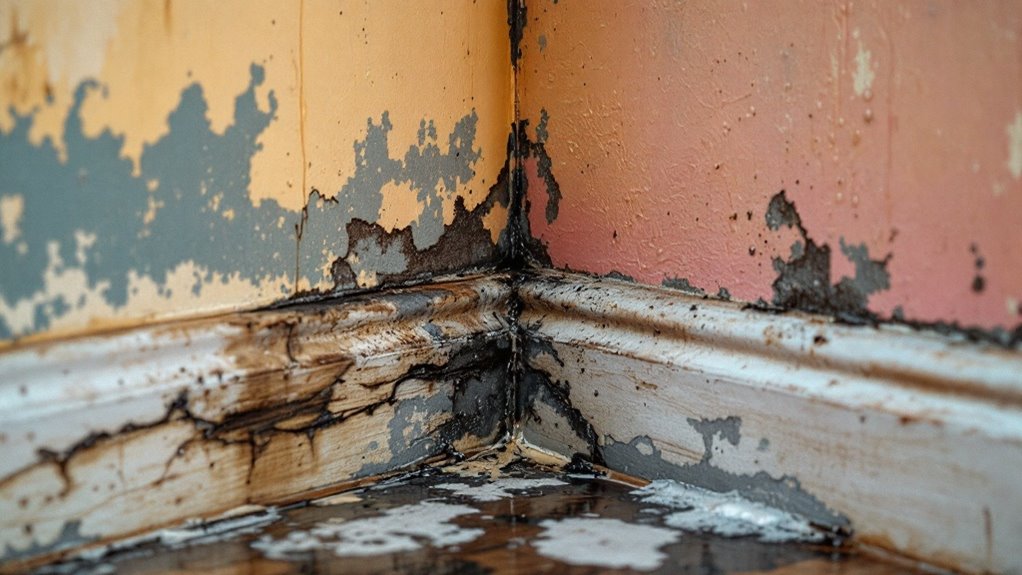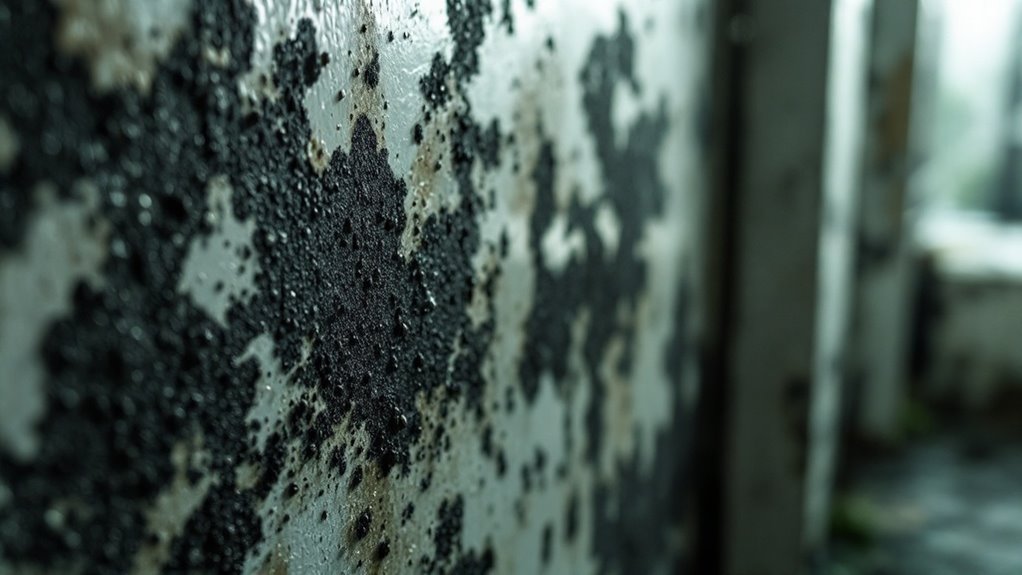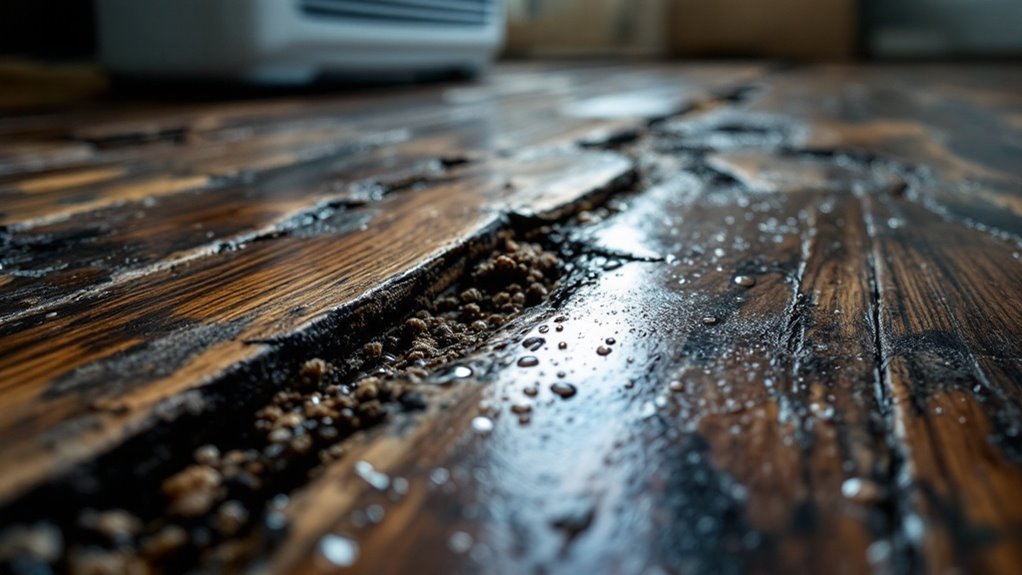Did you know that hidden moisture can silently wreak havoc on your home long after a water leak has been fixed? It’s not just about the visible damage; this moisture can weaken structures, attract pests, and create a mold paradise. Understanding the dangers lurking beneath the surface is essential. What signs should you look for, and how can you effectively combat this invisible enemy? Let’s investigate the implications and solutions together.
Key Takeaways
- Hidden moisture can weaken structural elements like wood and insulation, leading to costly repairs over time.
- It creates an environment conducive to mold growth, which can occur within 24 to 48 hours after a leak.
- Prolonged dampness attracts pests like termites and rodents, posing additional risks to your property.
- Increased humidity from hidden moisture can contribute to respiratory issues and allergies, impacting health.
- Properties with hidden moisture typically experience decreased market value, making timely detection crucial.
Understanding the Impact of Water Leaks

When you experience a water leak, it’s easy to focus solely on the visible damage, but hidden moisture can have far-reaching effects. You might think your walls and floors are intact, but moisture can seep into materials, leading to structural issues over time. This hidden water can weaken wood, compromise insulation, and even affect your home’s foundation. It doesn’t stop there; your indoor air quality might suffer too. Mold and mildew thrive in damp environments, potentially impacting your health. Recognizing the signs of hidden moisture is essential. By addressing the problem quickly, you can minimize damage and protect your home. Regular checks and prompt repairs are critical to maintaining a safe and healthy living environment, as increased water bills can also indicate hidden plumbing leaks that exacerbate moisture issues.
The Dangers of Hidden Moisture
Hidden moisture poses significant dangers that can quietly escalate if left unchecked. You might not see it, but its effects can be severe and costly. Here are some of the key risks associated with hidden moisture:
- Structural Damage: Prolonged moisture can weaken the integrity of walls and ceilings, leading to costly repairs.
- Pest Infestations: Damp conditions attract pests like termites and rodents, which can cause further damage.
- Health Risks: Hidden moisture can contribute to respiratory issues and allergies because of increased humidity and potential contaminants.
- Decreased Property Value: Properties with hidden moisture issues may face diminished market value, making them harder to sell.
Taking action against hidden moisture is vital to protecting your home and health. Don’t wait for the problems to surface! Additionally, professional assistance in identifying and mitigating hidden moisture can help ensure your property remains safe and sound.
How Mold Develops in Damp Environments

Mold thrives in damp environments since it needs moisture to grow and reproduce. When water leaks occur, hidden moisture can seep into walls, under floors, or in insulation, creating the perfect breeding ground for mold. The spores, which are always present in the air, can quickly settle in these damp areas. Given warmth and humidity, they start to germinate and form colonies. Within just 24 to 48 hours, you may see visible mold growth. As it spreads, it can release more spores into the air, leading to potential health risks and structural damage. To combat this, it’s essential to address any water leaks promptly and guarantee proper ventilation, reducing moisture levels and inhibiting mold development. Additionally, proactive maintenance can help identify early signs of plumbing failures and prevent water damage before it leads to mold growth.
Identifying Signs of Hidden Moisture
How can you tell if there’s hidden moisture in your home? Spotting these signs early can save you from bigger issues down the line. Here are some key indicators to watch for:
- Water stains: Look for discoloration on walls or ceilings, which may indicate leaks behind the surface.
- Musty odors: If you detect a damp, earthy smell, it might mean mold is forming because of hidden moisture.
- Warped floors or walls: Buckling or bending surfaces can signal underlying water problems.
- Condensation: Excessive moisture on windows or pipes may suggest high humidity levels, which can lead to hidden moisture.
Stay vigilant, and you’ll better protect your home from the dangers of hidden moisture.
Effective Water Damage Restoration Techniques

Once you’ve identified hidden moisture in your home, it’s vital to act quickly to mitigate water damage effectively. Start by removing any standing water using a wet vacuum or pump. Next, use fans and dehumidifiers to dry out affected areas, making sure you target walls, floors, and hidden spaces. It’s critical to check insulation and drywall, as they can trap moisture. If materials are too saturated, consider replacing them to prevent mold growth. Clean and disinfect surfaces to eliminate bacteria and odors. Finally, monitor humidity levels to guarantee they remain low. By following these steps, you’ll protect your home from further damage and create a healthier living environment. Don’t underestimate the importance of thorough restoration!
Prevention Strategies to Avoid Future Leaks
To prevent future leaks, it’s vital to regularly inspect your plumbing and appliances for signs of wear and tear. By staying proactive, you can catch potential problems before they escalate. Here are some key strategies to implement:
- Check for drips: Look under sinks and around appliances for any water accumulation.
- Inspect hoses: Examine washing machine and dishwasher hoses for cracks or bulges.
- Monitor water pressure: Verify your water pressure isn’t too high, which can stress your plumbing.
- Replace old fixtures: Upgrade faucets and pipes that show signs of corrosion or damage.
When to Seek Professional Help
Even with diligent preventive measures, situations can arise where professional help becomes necessary. If you notice persistent musty odors, visible mold growth, or water stains on walls or ceilings, it’s time to call in the experts. Hidden moisture can lead to serious structural damage and health risks if left untreated. Moreover, if you’ve tried drying the area yourself but the problem persists, don’t hesitate to seek assistance. Professionals have specialized equipment to detect moisture that’s invisible to the naked eye. They can likewise provide valuable insights on preventing future leaks. Remember, addressing these issues sooner rather than later can save you time, money, and stress in the long run. Trust your instincts—when in doubt, it’s best to consult a professional.
Conclusion
To sum up, hidden moisture is a silent threat that can wreak havoc on your home. Did you know that mold can start growing within just 24 to 48 hours after a water leak? This means you could be facing serious health risks and costly repairs before you even realize what’s happening. Staying vigilant and addressing water leaks promptly is essential. Don’t wait for the signs to appear—act now to protect your property and your family’s health.
